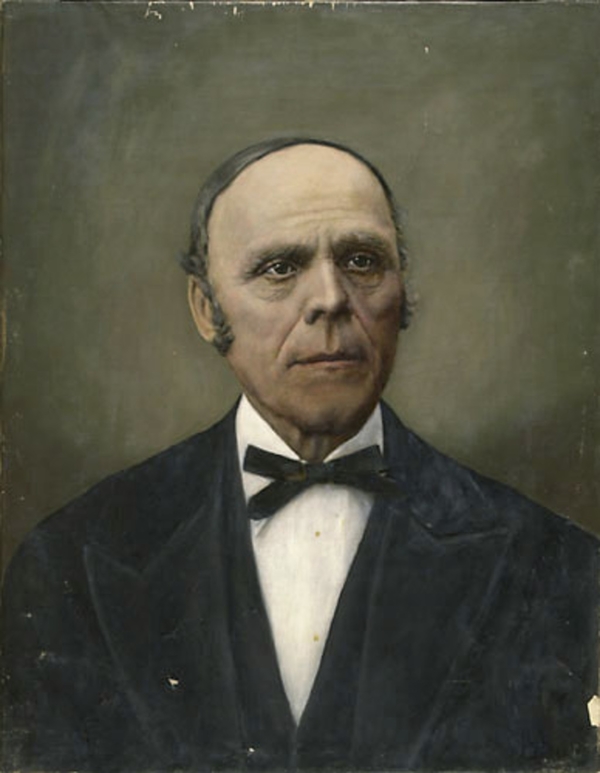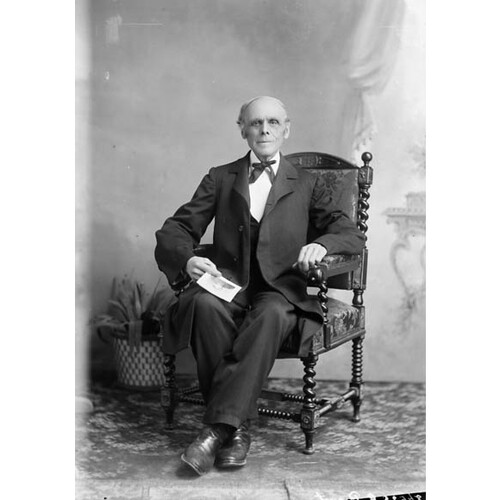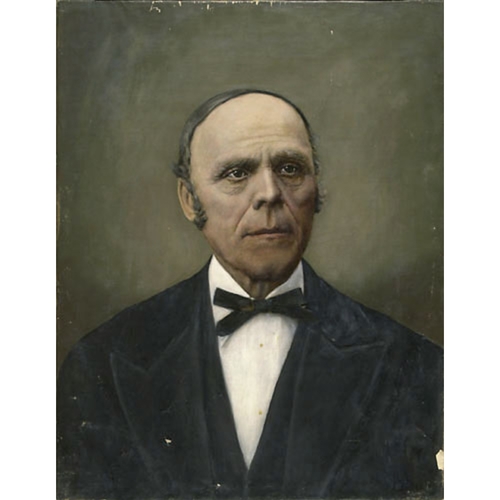
Source: Link
PAQUET, ZÉPHIRIN, merchant and manufacturer; b. 20 Dec. 1818 in Pointe-aux-Trembles (Neuville), Lower Canada, son of Joseph Paquet, a farmer, and Elisabeth Picher; m. 1 Aug. 1843 Marie-Louise Hamel at Quebec, and they had nine children; d. there 26 Feb. 1905.
The eldest boy in a family of 18, Zéphirin Paquet did not go to school. Hired at the age of 14 by a farmer in his village, he began working for a dairy in the faubourg Saint-Jean at Quebec in 1834. Two years later he bought his first cow and set up his own business in that district. He soon increased his herd and by 1840 had 20 cows grazing in Upper Town. His was the largest dairy in the city and by 1845 he had accumulated a small amount of capital. That year his barn burned down when fire swept the faubourg Saint-Jean and faubourg Saint-Louis, but he managed to save his cows and relocated his business to a fast-growing district in Lower Town near the Hôpital Général. His wife opened a small store in their home, selling hats, notions, and clothing.
Late in 1848 Marie-Louise told him that she was earning more in her store than he in his dairy and suggested that he join her in the clothing business. When Zéphirin refused to believe her, she challenged him to compare the earnings of the two businesses over the next year and to accept her suggestion if the figures proved her claim. At the end of 1849 the results were conclusive and Paquet sold his cows. The store occupied the entire ground floor of their house. Marie-Louise took care of sales and Zéphirin was responsible for purchases from John McCall of the Quebec firm of A. Laurie and Company as well as for customers, employees, and merchandise. By 1858 the enterprise had grown, expanding its clientele and increasing sales while operating strictly on a cash basis. The store burned down in the Saint-Sauveur fire of 1866, but the Paquets were able to remove their inventory quickly enough to save it. They took up residence on Rue Saint-Joseph, in the heart of Saint-Roch ward, where they remained in business.
Although they initially thought of their Saint-Roch location as temporary, it gradually assumed a permanent character. Paquet went from being a tenant to a property owner in 1878, when he gave up his live-in store and purchased a four-storey building. In the next dozen years he acquired adjacent blocks of land and buildings between Rue Saint-Joseph and Rue des Fossés (Boulevard Charest) for $60,000 cash. The business, run entirely by Zéphirin while his wife raised their nine children, continued to grow and diversified its line of products. Paquet built and expanded, and hired increasing numbers of employees. In 1890, although 72 years old, he still ruled over the ever-growing enterprise, whose workforce by then included some 150 people.
The question of succession was somewhat problematic. Only Joseph-Arthur, born in 1857, had the ability and good health needed to take over. The eldest son, Zéphirin, born in 1846, was shunted aside, and disinherited by his father in 1892, and then later by Joseph-Arthur, who made a bequest instead to Zéphirin’s wife, Caroline Monier. The other brother, Joseph-Octave, born in 1853, seems to have been involved in the business briefly, but because of ill health he became just a clerk in 1898. Joseph-Arthur was the mainspring of the firm in the 1890s, and in 1898 the transfer of control to him was confirmed by his parents through a legal settlement. His father was by this time almost 80 and his health had begun to deteriorate as a result of an “infirmity of old age” that afflicted him for the rest of his life.
In the 1890s the enterprise underwent considerable expansion. Retail sales continued to grow and it branched out into manufacturing, with fur processing in 1892 and the making of straw hats. It employed a total of 250 workers. Seeking to improve production methods, Paquet hired American technicians and managers on salary plus commission to train and oversee the employees and keep abreast of new techniques and machines. The business had assets on 31 March 1901 of $1,567,872, including an inventory of merchandise worth $834,313 and properties, furniture, and machinery totalling $421,467; with liabilities of only $722,639, it thus had an accumulated surplus of $845,233. The enterprise was made up of two units of comparable size. Z. Paquet, a large retail store on Rue Saint-Joseph, represented 46 per cent of its total trade, while the other 54 per cent was accounted for by J.-A. Paquet, manufacturer and wholesaler in Pointe-aux-Lièvres and Limoilou. Z. Paquet sold clothing, fabrics, hats, gloves, furs, and shoes, as well as furniture, mattresses, kitchen utensils, toys, carpets, tarpaulins, suitcases, umbrellas, silverware, perfume, and books. Most of J.-A. Paquet’s output – 75 per cent – consisted of furs, but it also produced leather gloves and mittens, straw hats, moccasins, and snowshoes. J.-A. Paquet was one of the largest industrial enterprises in the city of Quebec. It also had retail outlets in Montreal, Winnipeg, Toronto, and Vancouver, and sold on consignment in London and Paris.
Less than three years after his parents transferred control to him, Joseph-Arthur became gravely ill and drew up his will; he died on 29 March 1901. Only three days earlier he had incorporated the business as the Compagnie Paquet Limitée. He instructed his executors, the notary Vildebon-Winceslas Larue and his trusted manager George-Alfred Vandry, to complete the organization of the company and divide the assets of his estate among his sisters, brothers, and sisters-in-law. The settlement of the estate ran into difficulty, notably as a result of obstruction by his brother Zéphirin. The executors – in 1907 Victor de Lotbinière Laurin, Joseph-Arthur’s brother-in-law, replaced Larue, who had died – ran the firm, and that year they sold the estate’s assets to the Compagnie Paquet Limitée for $1,150,942, payable in shares of the company and cash. The principal beneficiaries, who thereby became the company’s principal shareholders, were Joséphine Paquet, Laurin’s wife, who received $385,559, and Joseph-Octave Paquet and Caroline Monier, the younger Zéphirin’s wife, who each received $257,039.
Zéphirin Paquet died on 26 Feb. 1905 and thus did not live to see this settlement. However, Le Soleil on 1 March 1905 published an advertisement that was a sign of the times: “Colossal Sale, Gigantic, Absolutely Unique . . . . Our special huge sales had to be interrupted for our three days of mourning. We wish to make up for these three days of inactivity as much as possible.” A new era had begun.
AC, Québec, État civil, Catholiques, Saint-Roch (Québec), 28 févr. 1905; Minutiers, Cyprien Labrèque, 29 mars 1901; V.-W. Larue, 5 août 1892; 7, 18, 30 juin 1898; 31 juill., 20 oct. 1900; W.-R. LaRue, 12 déc. 1901; 4 juin 1907; 20 juin, 8 août 1908; L.-P. Sirois, 1886. ANQ-Q, CE1-1, ler août 1843; CE1-15, 20 déc. 1818. Baker Library, R. G. Dun & Co. credit ledger, Canada, 8: 84. Le Soleil, 27 févr., ler mars 1905. Benoit. “Le développement des mécanismes de crédit et la croissance économique d’une communauté d’affaires.” Bradstreet commercial report, 1859–1905. Can., Royal commission on labour and capital, Report. Alyne Le Bel, “Une vitrine populaire; les grands magasins Paquet,” Cap-aux-Diamants (Québec), 4 (1988–89), no.2: 45–18. Mercantile agency reference book, 1859–1905. Pierre Poulin, “Au tournant du siècle; ateliers et manufactures devêtements,” Cap-aux-Diamants, 4, no.2: 49–50; “Déclin portuaire et industrialisation.” Zéphirin Paquet; sa famille, sa vie, son œuvre (Québec, 1927).
Cite This Article
Marc Vallières, “PAQUET, ZÉPHIRIN,” in Dictionary of Canadian Biography, vol. 13, University of Toronto/Université Laval, 2003–, accessed December 23, 2025, https://www.biographi.ca/en/bio/paquet_zephirin_13E.html.
The citation above shows the format for footnotes and endnotes according to the Chicago manual of style (16th edition). Information to be used in other citation formats:
| Permalink: | https://www.biographi.ca/en/bio/paquet_zephirin_13E.html |
| Author of Article: | Marc Vallières |
| Title of Article: | PAQUET, ZÉPHIRIN |
| Publication Name: | Dictionary of Canadian Biography, vol. 13 |
| Publisher: | University of Toronto/Université Laval |
| Year of publication: | 1994 |
| Year of revision: | 1994 |
| Access Date: | December 23, 2025 |




